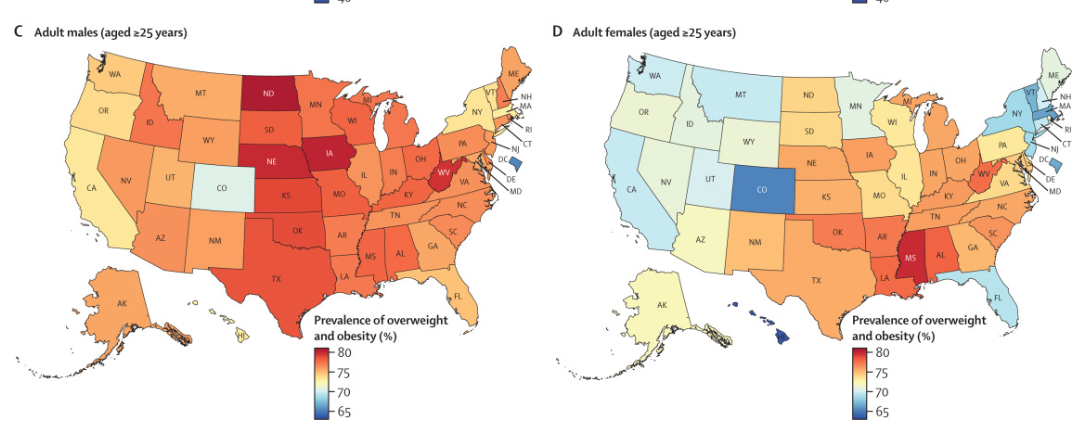
On November 14, the Global Burden of Disease (GBD) 2021 Obesity Forecasting Collaborators published an analysis of self-reported and measured data from 134 sources on the estimation and prevalence of overweight and obesity between 1980 and 2021. The analysis, published in The Lancet, forecasts on the US national level for children and adolescents (age 5-24 years) and adults (age ≥25 years) up to 2050. The collaborators also derived state-specific (including Washington, DC) estimates and projections for older adolescence (age 15-24 years) and adults.
Methods
Data included all major national US Centers for Disease Control and Prevention surveillance survey data and can be found on the Global Health Data Exchange. Adjustments were made to correct for self-reporting bias.
For individuals older than 18 years, overweight was defined as a body mass index (BMI) of 25 to 30, and obesity was defined as BMI ≥30. For individuals younger than 18 years, BMI definitions were based on International Obesity Task Force criteria.
Historic trends of overweight and obesity prevalence between 1990 and 2021 were estimated using spatiotemporal Gaussian process regression models. A generalized ensemble modeling approach was then used to derive projected estimates up to 2050.
Estimates were calculated by age and sex at the national level as well as further estimates for all 50 states, including Washington, DC, for children (age ≤5 years), younger adolescents (age 5-14 years), older adolescence (age 15-24 years), and adults (age ≥25 years).
Ninety-five percent uncertainty intervals (UIs) were derived from the 2.5th and 97.5th percentiles of the posterior distributions of the respective estimates.
2021 National Overweight and Obesity Data
According to 2021 national overweight and obesity data, an estimated 15.1 million (95% UI, 13.5-16.8) children and younger adolescents, 21.4 million (95% UI, 20.2-22.6) older adolescents, and 172 million (95% UI, 169-174) adults had overweight or obesity in the United States.
Texas had the highest age-standardized prevalence of overweight or obesity for older male adolescents at 52.4% (95% UI, 47.4-57.6), and Mississippi had the highest prevalence for older female adolescents at 63% (95% UI, 57-68.5).
North Dakota had the highest prevalence of overweight or obesity in male adults, estimated at 80.6% (95% UI, 78.5-82.6) while Mississippi had the highest prevalence for female adults, estimated at 79.9% (95% UI, 77.8-81.8).
More adolescent females than males had obesity, with an estimated prevalence of 28.8% (95% UI, 25.4-32.5) and 22.7% (95% UI, 20.3-25.1), respectively. Similar to adolescents, more adult females than males had obesity, with an estimated prevalence of 45.6% (95% UI, 43.7-47.5) and 41.5% (40.1-43.2), respectively.
1990-2021 National Overweight and Obesity Trends, 2050 Forecasts
From 1990 to 2021, the percentage change in the age-standardized prevalence of obesity increased by 158.4% (95% UI, 123.9-197.4) in older male adolescents and 185.9% (95% UI, 139.4-237.1) in older female adolescents. The percentage change in prevalence of obesity was 123.6% (95% UI, 112.4-136.4) in male adults and 99.9% (95% UI, 88.8-111.1) in female adults.
According to the collaborators, forecast results suggest that if past trends and patterns continue, an additional 3.33 million children and younger adolescents, 3.41 million older adolescents, and 41.4 million adults will have overweight or obesity by 2050. In the same year, 43.1 million (95% UI, 37.2-47.4) children and younger and older adolescents will have overweight or obesity; 213 million (95% UI, 202-221) adults will have overweight or obesity.
The projection for most states in 2050 is that one in five children and younger adolescents, one in three older adolescents, and two in three adults will have obesity. Sex inequities are also projected to widen over time, with a particularly concerning 2050 forecast of more than 50% of older female adolescents having obesity in Mississippi, Arkansas, Oklahoma, and Alabama.
“Although these patterns in late adolescence are consistent with puberty-related sex differences in fat mass, the magnitude of the difference in prevalence signals that interventions need to be tailored by sex,” according to the collaborators.
Southern states (Oklahoma, Mississippi, Alabama, Arkansas, West Virginia, and Kentucky) are forecasted to continue having a high prevalence of obesity. Of note, the highest percentage changes predicted from 2021 data are projected to be in Utah for adolescents and Colorado for adults.
The collaborators concluded that “Future strategies must involve a multifaceted, whole-system approach, taking into consideration the complex drivers of obesity.
“To protect population health, avoid overwhelming the health-care system, and mitigate mounting health-care costs, deliberate concerted action is needed to disrupt the epidemic of overweight and obesity.”







 © 2025 Mashup Media, LLC, a Formedics Property. All Rights Reserved.
© 2025 Mashup Media, LLC, a Formedics Property. All Rights Reserved.